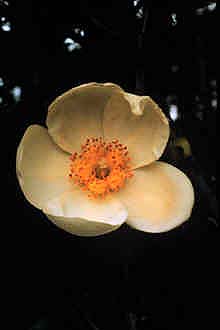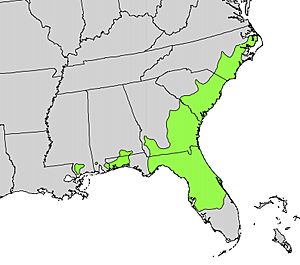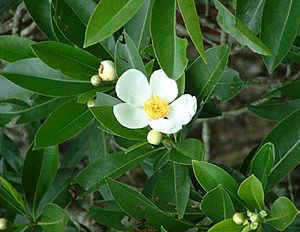Loblolly-bay facts for kids
Quick facts for kids Loblolly-bay |
|
|---|---|
 |
|
| A beautiful Gordonia lasianthus flower | |
| Conservation status | |
| Scientific classification | |
| Genus: |
Gordonia (plant)
|
| Species: |
lasianthus
|
 |
|
| Where loblolly-bay naturally grows | |
The Gordonia lasianthus, also known as loblolly-bay, holly-bay, or just gordonia, is a small to medium-sized evergreen tree or shrub. It grows in wet, swampy soils in the southeastern United States, especially in pinelands and bays along the Atlantic and Gulf Coasts. This tree is part of the Theaceae family, which is the same family as tea plants!
Loblolly-bay grows slowly. Its wood is soft and light-colored, ranging from cream to reddish-brown. It's not usually used for commercial products, but it could be used to make paper pulp. When older trees are cut, their wood gives off a strong smell, like a mix of fresh oranges and pine sap. The bark of adult trees can be medium gray or reddish-brown. If a dead loblolly-bay tree is left in the sun for a few years, its wood can become shiny.
People like to plant loblolly-bay because of its pretty white flowers and shiny leaves. However, it can be tricky to grow. Deer also like to eat the new sprouts that grow from cut stumps.
Contents
Where Loblolly-Bay Lives
Its Natural Home
Loblolly-bay grows all along the Atlantic and Gulf Coastal Plains. You can find it from southern Virginia down to the Florida Panhandle. There are also smaller groups of these trees in Florida, coastal parts of Alabama, Mississippi, southern Louisiana, and parts of Texas. In South Carolina, it's very common in the lower coastal areas, but in other parts, it only grows in special spots.
Weather It Likes
The loblolly-bay prefers a climate with mild winters and warm summers. It needs a lot of rain, usually between 1120 mm (44 inches) and 1630 mm (64 inches) each year. Most of this rain falls during the summer and early fall months (June to October). It also needs many frost-free days to grow well.
Soil and Land It Prefers
Loblolly-bay is very picky about the soil it grows in. It can be found in several types of soil, including Spodosols, Inceptisols, Ultisols, and Histosols, which are often very acidic.
The soil where loblolly-bay grows usually has these features:
- The top layer (0 to 25 cm deep) is black to dark gray, made of fine sand, and very acidic.
- Below that, the soil (25 to 38 cm deep) is often black or gray sand, also very acidic.
- Deeper down (38 to 127 cm), the soil is gray or brown sand, still very acidic.
These trees grow in flat woodlands or shallow dips in the land. The ground usually has little slope, and water drains slowly, meaning the soil stays wet. The water level is often at or near the surface for 6 to 9 months of the year. In South Carolina, you often find loblolly-bay in wet, flat areas and in special oval-shaped wetlands called Carolina Bays.
Other Trees It Grows With
Loblolly-bay often shares its home with other types of trees and plants. It's found in five main forest cover types in the Atlantic Coastal Plain.
- In some Carolina Bays, it grows near pondcypress (Taxodium distichum var. nutans). Loblolly-bay usually stays on the drier edges of these bays, alongside loblolly pine (Pinus taeda) and redbay (Persea borbonia var. borbonia). Smaller plants like fetterbush (Lyonia lucida), inkberry (Ilex glabra), and greenbrier (Smilax spp.) are also found there.
- It's a small part of forests with loblolly pine and other hardwoods. Here, it grows with trees like water oak (Quercus nigra), sweetgum (Liquidambar styraciflua), American holly (Ilex opaca), longleaf pine (Pinus palustris), and yellow-poplar (Liriodendron tulipifera). Loblolly-bay only appears in the wettest spots of these forests.
- You might also find it in forests with Atlantic white-cedar (Chamaecyparis thyoides), along with pond pine (Pinus serotina), swamp cyrilla (Cyrilla racemiflora), redbay, and sweetbay (Magnolia virginiana).
- In wet flats and some Carolina Bays, loblolly-bay is found with pond pine, sweetbay, and redbay. These trees often don't form a thick canopy. Instead, there's a dense layer of shrubs like fetterbush, greenbrier vines, and inkberry.
- It's also a minor tree in "broadleaf evergreen forests" of the lower Coastal Plain. Here, it grows with red maple (Acer rubrum), black tupelo (Nyssa sylvatica var. sylvatica), sweetgum, and water oak.
Loblolly-Bay Life Cycle
Reproduction and Early Growth
Flowering and Fruiting: Loblolly-bay flowers have both male and female parts. The flower buds start to form when new leaves grow. The flowers usually appear from late June to early July and can be seen until mid-August. Each flower stays open for only one or two days. Tiny insects like humble bees, thrips, flies, and even hummingbirds help pollinate them. After a couple of days, the petals fall off, leaving behind the part that will become the fruit.
Seed Production and Spreading: As the fruits grow, they turn brown and split into five sections. The mature, open fruits are first seen in September or October, and all of them open by mid-December. The wind shakes the light, winged seeds out of the fruits. Most seeds fall close to the parent tree. About 60% of the seeds land within a distance equal to half the tree's height, and 94% fall within a distance equal to the tree's full height.
Seedling Development: Loblolly-bay seeds can sprout easily in good conditions, with 70% to 80% germinating within 10 days. However, very few seedlings are seen growing in the wild, and most of them don't survive past their first year. Young loblolly-bay plants seem to need open areas and exposed soil to grow. Older seedlings have only been found where the soil has been disturbed, like in recently plowed fire lines.
The first growth of seedlings is slow. After three years, they might only be 10 to 15 cm (4 to 6 inches) tall. By eight years, they are still only about 30 to 40 cm (12 to 16 inches) high.
Vegetative Reproduction: Loblolly-bay often reproduces from its roots or stumps rather than from seeds. If a tree is cut down, new sprouts can grow from the stump, sometimes as much as 1 meter (3 feet) in the first year! Deer love to eat these new sprouts. Also, if the trees are killed by fire or if their roots are damaged, many new sprouts can grow from the base of the plant.
Growing Up: From Sapling to Mature Tree
Growth and Size: Once loblolly-bay trees get past the seedling stage (around 5 to 15 years old), they grow quite fast. They can grow about 0.6 meters (2.0 feet) taller each year. A 10-year-old tree might be about 6.5 meters (21.3 feet) tall. Their trunks also grow about 0.4 cm (0.2 inches) wider each year.
Root System: The roots of loblolly-bay trees show how much they like to sprout. Many trees have a large main side root with smaller roots branching downwards.
Dealing with Competition: Loblolly-bay can handle some shade. In wet, flat areas where there aren't too many other trees, loblolly-bay is a strong competitor. It often grows taller than pines in nearby drier areas. However, if other trees grow too tall and block its sunlight, older loblolly-bay trees can lose their cone shape, and their tops might break apart.
Threats: Loblolly-bay trees don't seem to have many insect or disease problems. However, they are very sensitive to fire. Their thin bark and shallow roots make them easily damaged by fires. Dead wood from loblolly-bay also rots very quickly and can be affected by fungi.
Special Uses of Loblolly-Bay
For a long time, people have used loblolly-bay in landscaping because it's a beautiful and tough tree. It has glossy, dark-green leaves and lots of white flowers. Its wood has been used to make cabinets, and its bark can be used to make a tanning agent for leather. If you soak the bark in warm water, it will dye the water a rich red color!
Because loblolly-bay can grow well in wet, boggy areas where other trees like loblolly pine don't do as well, it could be a good option for managing these types of lands.
Scientists have also tested loblolly-bay wood for making paper. The results show that it produces a good amount of pulp (52%) and the paper made from it is strong. This means loblolly-bay could be a useful tree for paper mills, especially those in the lower Coastal Plain of South Carolina that already use it in their hardwood pulp.



